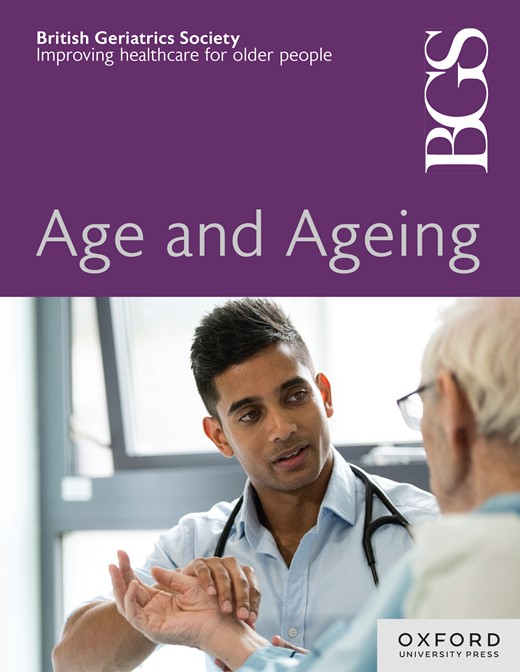Identifying predictors of medication-related harm in older populations: a latent class analysis approach
IF 7.1
2区 医学
Q1 GERIATRICS & GERONTOLOGY
引用次数: 0
Abstract
Background The aim of this study was to apply latent class analysis to identify underlying groupings of predictors, including drug classes and clinical predictors, co-occurring in older people at higher risk of medication-related harm. Method The Adverse Drug reactions in an Ageing PopulaTion cohort was used (N = 798 patients aged ≥65 years admitted acutely to hospital). Seven drug classes; antithrombotic agents, diuretics, renin-angiotensin-aldosterone system, calcium channel blockers, beta-blocking agents, psychoanaleptics, non-steroidal anti-inflammatory drugs, and comorbidity, frailty and significant polypharmacy (10+ different drug classes) were included as potential predictors of medication-related harm. Medication-related harm outcomes included adverse drug reactions (ADR)-related hospital admissions, health-related quality of life, functional impairment and emergency department visits. Determination of the best number of latent classes was based on standard comparison of fit statistics. Univariate and multivariable logistic, linear and Poisson regression models were used to examine the associations between the latent groups and the medication-related harm outcomes. Results A five class model was determined to fit best; (i) high-risk prescribing and polypharmacy group (N = 245); (ii) low-risk group (n = 138); (iii) high-risk prescribing only group (N = 332); (iv) antihypertensive group (N = 18); and (v) psychoanaleptics and polypharmacy group (N = 65). Patients in both the high-risk prescribing and polypharmacy group (a.OR = 2.59, 95%CI = 1.51–4.44) and the high-risk prescribing only group (a.OR = 2.85, 95%CI = 1.57–5.20) were more likely to have an ADR-related hospital admission, with the high-risk prescribing and polypharmacy group also having statistically significant higher functional impairment (β = 1.21, 95% CI = 0.09, 2.33) compared to those in the low-risk group. Conclusion Identifying distinct subgroups of older people based on their medications may lead to more targeted and tailored interventions to reduce potential medication-related harm.识别老年人群中药物相关危害的预测因素:一种潜在分类分析方法
本研究的目的是应用潜在类别分析来确定潜在的预测因素分组,包括药物类别和临床预测因素,这些预测因素共同发生在药物相关伤害风险较高的老年人中。方法采用老年人群不良反应队列(N = 798例≥65岁急性住院患者)。七种药物类别;抗血栓药、利尿剂、肾素-血管紧张素-醛固酮系统、钙通道阻滞剂、β -阻滞剂、精神镇痛药、非甾体抗炎药、合并症、虚弱和明显的多药(10多种不同的药物类别)被纳入药物相关伤害的潜在预测因素。与药物相关的伤害结果包括与药物不良反应(ADR)相关的住院、与健康相关的生活质量、功能损害和急诊就诊。根据拟合统计量的标准比较确定最佳潜在分类数。使用单变量和多变量logistic、线性和泊松回归模型来检验潜在组与药物相关危害结果之间的关系。结果确定五类模型拟合最佳;(i)高危处方和多药组(N = 245);(ii)低危组(n = 138);(iii)只开处方的高危组(N = 332);(iv)抗高血压组(N = 18);(v)精神镇痛药及复方药物组(N = 65)。高危开处方和多药组(a.OR = 2.59, 95%CI = 1.51-4.44)和仅高危开处方组(a.OR = 2.85, 95%CI = 1.57-5.20)的患者发生adr相关住院的可能性更高,且高危开处方和多药组的功能损害发生率也高于低危组(β = 1.21, 95%CI = 0.09, 2.33)。结论根据用药情况确定不同的老年人亚群,可能会导致更有针对性和量身定制的干预措施,以减少潜在的药物相关危害。
本文章由计算机程序翻译,如有差异,请以英文原文为准。
求助全文
约1分钟内获得全文
求助全文
来源期刊

Age and ageing
医学-老年医学
CiteScore
9.20
自引率
6.00%
发文量
796
审稿时长
4-8 weeks
期刊介绍:
Age and Ageing is an international journal publishing refereed original articles and commissioned reviews on geriatric medicine and gerontology. Its range includes research on ageing and clinical, epidemiological, and psychological aspects of later life.
 求助内容:
求助内容: 应助结果提醒方式:
应助结果提醒方式:


